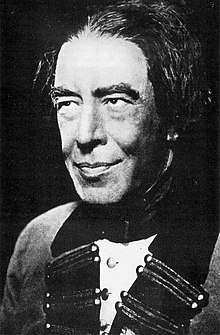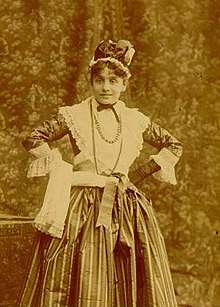The Mistress of the Inn
The Mistress of the Inn (Italian: La locandiera [la lokanˈdjɛːra]), also translated as The Innkeeper Woman or Mirandolina (after the play's main character), is a 1753 three-act comedy by the Italian playwright Carlo Goldoni about a coquette.[1] The play has been regarded as his masterpiece.[2] Frederick Davies describes it as Goldoni's Much Ado About Nothing.[3]
| The Mistress of the Inn | |
|---|---|
 Constantin Stanislavski as Ripafratta in 1898. | |
| Written by | Carlo Goldoni |
| Date premiered | 1753 |
| Place premiered | Republic of Venice |
| Original language | Italian |
| Subject | Coquetry |
| Genre | Comedy |
| Setting | Mirandolina's inn in Florence |
Characters
- Mirandolina, the mistress of the inn
- Baron Ripafratta
- Marquis of Forlipopoli
- Count of Albafiorita
- Fabrizio, a servant of the inn
- the Baron's servant
- Ortensia
- Dejanira
Production history
Eleonora Duse is one of the actresses to have played its lead role, Mirandolina; she gave a command performance for Queen Victoria at Windsor on 18 May 1894.[4]
The play was one of those produced by the world-famous Moscow Art Theatre (MAT) in its first season.[5] This production opened in a double-bill with Greta's Happiness by Emilia Matthai on 2 December 1898.[5] It was directed by Constantin Stanislavski, who also played the misogynist Ripafratta.[6] Stanislavski directed the play in a second production at the MAT, which opened on 3 February 1914 after 112 rehearsals.[7] He played the role of Ripafratta once more.[8] The artist Alexandre Benois provided the scenic design for this production, which was conceived as a showcase for the actress Olga Gzovskaya.[9]
Adaptations
In 1773 the Venetian composer Antonio Salieri and the librettist Domenico Poggi adapted the play as a three-act dramma giocoso.[10] In 1800 the German composer Simon Mayr and Italian librettist Gaetano Rossi adapted it as a two-act dramma giocoso.[11] The American composer Henry Kimball Hadley adapted it as a one-act comic opera called Bianca, which was first performed in 1918.[12] Bohuslav Martinů also produced an operatic version, his three-act Mirandolina, which was first performed in 1959. The play was also adapted into several films, notably Paolo Cavara's La locandiera and Tinto Brass' Miranda.

See also
| Italian Wikisource has original text related to this article: |
References
- Banham (1998, 433), Davies (1968, 191), Hartnoll (1983, 340), and Worrall (1996, 32).
- Hartnoll (1983, 340).
- Davies (1968, 191).
- Hartnoll (1983, 240).
- Benedetti (1999, 386) and Worrall (1996, 104-105).
- Benedetti (1999, 386) and Worrall (1996, 106).
- Benedetti (1999, 218, 387).
- Benedetti (1999, 387).
- Benedetti (1999, 217).
- Rice (1992).
- Balthazar (1992).
- Boardman (1932, 131-132).
Sources
- Balthazar, Scott L. 1992. "Mayr, Simon." In The New Grove Dictionary of Opera. Ed. Stanley Sadie. London: Macmillan. ISBN 0-333-73432-7.
- Banham, Martin, ed. 1998. The Cambridge Guide to Theatre. Cambridge: Cambridge UP. ISBN 0-521-43437-8.
- Benedetti, Jean. 1999. Stanislavski: His Life and Art. Revised edition. Original edition published in 1988. London: Methuen. ISBN 0-413-52520-1.
- Boardman, Herbert R. 1932. Henry Hadley: Ambassador of Harmony. Georgia: Banner P.
- Davies, Frederick, trans. 1968. Four Comedies. By Carlo Goldoni. London: Penguin. ISBN 0-14-044204-9.
- Hartnoll, Phyllis, ed. 1983. The Oxford Companion to the Theatre. 4th ed. Oxford: Oxford UP. ISBN 0-19-211546-4.
- Rice, John A. 1992. "Salieri, Antonio." In The New Grove Dictionary of Opera. Ed. Stanley Sadie. London: Macmillan. ISBN 0-333-73432-7.
- Worrall, Nick. 1996. The Moscow Art Theatre. Theatre Production Studies ser. London and NY: Routledge. ISBN 0-415-05598-9.
External links
- The Mistress of the Inn at the Internet Broadway Database
